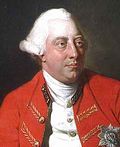 |
George III
b. 24 May/4 Jun 1738, London
d. 29 Jan 1820, Windsor Castle, Windsor, Berkshire |
| Title: |
By the Grace of God, King of Great Britain, France and Ireland, Defender of the Faith, etc. = Dei gratia, Magne Britannie, Francie et Hibernie Rex, Fidei Defensor, etc. |
| Term: |
25 Oct 1760 - 1 Jan 1801 |
| Chronology: |
25 Oct 1760, succeeded his grandfather, George II (proclaimed in London 25 Oct 1760) [1] |
|
22 Sep 1761, crowned, Westminster Abbey [2] |
|
1 Jan 1801, the royal style and titles are changed in accordance to a proclamation issued by command of the King of Great Britain on 1 Jan 1801 [3] |
| Names/titles: |
Baptized (21 Jun/2 Jul 1738): George William Frederick; Duke of Cornwall, Duke of Rothesay, Earl of Carrick, Baron Renfrew, Lord of the Isles, Great Steward of Scotland, Duke of Edinburgh, Marquess of the Isle of Ely, Earl of Eltham, Viscount of Launceston, Baron of Snowdon [from 20/31 Mar 1751]; Prince of Wales and Earl of Chester [from 20 Apr/1 May 1751]; Herzog zu Braunschweig und Lüneburg (Duke of Brunswick and Lüneburg) [25 Oct 1760 - 29 Jan 1820]; Erzschatzmeister und Kurfürst des Heiligen Römischen Reiches (Archtreasurer and Prince-Elector of the Holy Roman Empire) [25 Oct 1760 - 12 Oct 1814]; Roi de la Corse/Re di Corsica (King of Corsica) [19 Jun 1794 - 15 Oct 1796]; König von Hannover (King of Hanover) [12 Oct 1814 - 29 Jan 1820] |
|
By the Grace of God, of the United Kingdom of Great Britain and Ireland King, Defender of the Faith as George III [1 Jan 1801 - 29 Jan 1820] |
| Biography: |
| George William Frederick was the oldest son of Frederick Louis, Prince of Wales, and grandson of King George II. He was the first sovereign of the Hanoverian line to be born and educated as an Englishman. He was 12 when his father died (20/31 Mar 1751), leaving him heir to the throne, which he assumed in 1760 upon the death of his grandfather. George III regained most of the royal prerogatives exercised by the Whig ministers during the reigns of George I and George II. His favorite was the Earl of Bute, whose rise in power was matched by the decline of influence of the Duke of Newcastle and William Pitt the Elder. After a peace treaty at Fontainebleau, which ended the Seven Years' War (1756-1763), George III began general proscription of the Whigs dismissing them from many important offices. The ministerial instability of the late 1760's ended when Lord North became First Lord of the Treasury (28 Jan 1770). The main concern of his administration was the American War of Independence (1775-1783), which resulted in the loss of the British colonies in North America. After the fall of Lord North (27 Mar 1782), William Pitt the Younger became the principal minister of the Tory administration (1783-1801). As early as 1765 George III had suffered an apparent dementia, and in 1788 his derangement recurred to such a degree that the government faced the "Regency Crisis", during which Pitt attempted to place restriction on the Prince of Wales's exercise of the royal authority. A series of wars with the revolutionary France began in 1793 and continued until the Pitt's resignation in 1801. At the same time, the United Kingdom had emerged after "An Act for the Union of Great Britain and Ireland" was passed on 2 Jul 1800 (effective 1 Jan 1801). After the death of Pitt, who shortly returned to power in 1804-1806, the Whigs formed an administration, which called for peace with France and abolished the slave trade. The issue of Roman Catholic emancipation raised by the Whigs led to the resignation of the Grenville ministry and the Tories formed the following cabinets. In early December 1810 the king's insanity returned and assumed a violent character. The Regency Act was passed in 1811 and George Augustus Frederick, Prince of Wales, assumed the royal authority, which he exercised until the end of his father's reign.
|
| |
| [1] |
The London Gazette, No. 10046, 21 Oct - 26 Oct 1760, p. 1. |
| [2] |
The London Gazette, No. 10142, 22 Sep - 26 Sep 1761, pp. 2-4. |
| [3] |
The London Gazette, No. 15325, 3 Jan - 6 Jan 1801, pp. 23-24. |
| [4] |
Fryde, E.B., et al. (eds.) Handbook of British Chronology. London: Offices of the Royal Historical Society: University College, 1986. 3rd edition. online |
|
Image: portrait of King George III by Johann Zoffany. |